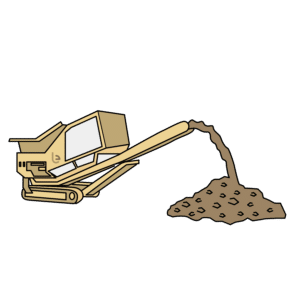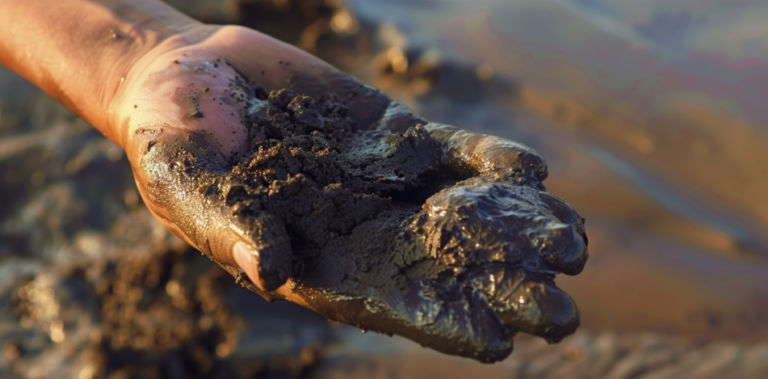Basics of drilling mud disposal
Definitions: Drilling mud, drill cuttings and bentonite
Drilling mud plays an essential role in deep drilling technology, especially in horizontal directional drilling (HDD drilling). This technology makes it possible to lay pipes and cables underground without open trenching, ensuring an intact surface between the entry and exit points. This approach not only offers significant environmental benefits by minimising soil disturbance, but is also economically advantageous by saving time and resources.
Drilling mud (also Drilling fluid) itself is a mixture of water, Bentonite (a clay mineral used for stabilisation and cooling in the drilling process), and various minerals. The exact composition of the drilling mud can vary depending on the geological conditions of the drilling site and the specific requirements of the well.
In addition, the drilling Cuttings The solid materials resulting from drilling are also disposed of. Both drilling mud and drill cuttings must be disposed of properly in order to avoid environmental pollution and fulfil legal requirements.
Waste classification of drilling muds
The disposal of drilling mud is subject to strict requirements under waste legislation. The classification of the drilling mud, which is based on its composition and potential environmental risks, plays a decisive role. The distinction between hazardous and non-hazardous waste is key here, as it sets the course for the disposal route. This categorisation directly influences the steps required for transporting, treating and ultimately storing the waste product.
The legal framework requires a detailed analysis of the physical and chemical properties of the drilling mud. Based on this, specific disposal methods are defined to ensure environmentally sound and legally compliant treatment. These processes should both minimise the ecological impact and ensure the protection of human health.
Legal requirements and guidelines
Circular economy and waste legislation
The Closed Substance Cycle Waste Management Act (KrWG) defines the legal basis for the handling of waste, including drilling mud. Central provisions that must be observed when disposing of drilling mud include
- § Section 3 (1) KrWGDefines what is meant by the term "waste", namely all substances or objects that the owner wants or needs to dispose of.
- § Section 3 (4) KrWGEmphasises the need for the owner to dispose of materials when they can no longer be used for their original purpose. This applies to drilling mud as soon as it results from the drilling process and has no further use.
These paragraphs underline the importance of careful and responsible disposal of drilling mud in order to both meet legal requirements and minimise environmental risks.
AVV numbers according to the waste catalogue
The Waste Catalogue Ordinance (AVV) is decisive for the correct classification and disposal of drilling mud. It contains
- § 2 para. 2 AVV: Regulations for classifying waste according to its type and origin using a six-digit code.
Strict compliance with these paragraphs ensures that drilling fluids are properly classified as waste and disposed of in accordance with legal requirements. This helps to reduce the environmental impact and ensure compliance with the principles of the circular economy.
Proper disposal of drilling mud
Drilling mud disposal process
The Proper disposal of drilling mud is a complex process that can involve various methods, depending on the composition and classification of the waste. Common methods include
- PreparationThe sludge is processed by physical or chemical treatment to remove water and pollutants. The aim is to reduce the volume and enable further utilisation of the components.
- LandfillNon-recyclable residues of the treated sludge are stored under strict conditions in specially designated landfills.
- Thermal treatmentThermal treatment may be useful in some cases to safely remove organic components.
The selection of the appropriate process depends on the chemical and physical properties of the drilling mud as well as the local legal requirements. Careful analysis and classification of the mud are therefore essential.
Selecting the correct AVV number
The Waste Catalogue Ordinance (AVV) plays a decisive role in the disposal of drilling mud. Choosing the correct AVV number is essential as it forms the basis for the disposal and treatment of the mud. Relevant numbers for drilling mud are
- AVV 01 05 04Sludges from the processing of gravel and sand as well as from gravel and clay washing.
- AVV 01 05 08Chloride-containing drilling muds and wastes other than those mentioned in 01 05 05 and 01 05 06.
The exact classification according to AVV numbers makes it possible to precisely determine the requirements for disposal and ensure that all legal and environmental standards are met.
Cost factors for drilling mud disposal
Factors influencing disposal costs
The costs for the Disposal of drilling mud can vary greatly and are influenced by various factors. The main influencing factors include
- Quantity of drilling fluidThe total amount of sludge produced has a direct influence on the costs. Larger quantities require more extensive logistics and cause higher disposal costs.
- Composition and classificationDepending on the chemical and physical composition, disposal can become more complex and therefore more expensive. Hazardous waste requires special treatment and disposal procedures.
- Transport costsThe distance between where the drilling mud is produced and the disposal or treatment plant can have a significant impact on costs. Longer transport routes lead to higher costs.
- Legal requirementsDisposal requirements, based on local and national regulations, may require additional treatment steps that increase overall costs.
Detailed analysis and planning are crucial in order to manage costs effectively and avoid surprises.
Cost reduction through professional processing systems
The use of professional treatment plants can be a key factor in reducing the cost of disposing of drilling mud. These facilities specialise in treating drilling mud to reduce volume and contaminant content. The benefits include:
- Volume reductionSeparation of solids and liquids can significantly reduce the volume of material to be disposed of, which in turn reduces disposal costs.
- Recycling of materialsCertain components of the drilling fluid, such as water or minerals, can be recycled. This not only reduces the amount to be disposed of, but can also generate revenue.
- Reduction of environmental impactProfessional treatment processes minimise the environmental impact and help to meet strict legal requirements. This can lead to long-term savings by avoiding the risk of penalties and sanctions.
-
TIP
Investing in cooperation with specialised waste management companies and treatment plants can therefore lead to considerable cost savings in the long term and at the same time improve the environmental compatibility of the disposal processes.
The role of additives in drilling mud utilisation
Use of bentonite and its legal framework
Bentonite, a naturally occurring clay mineral, plays an essential role in the composition of drilling mud. It is valued for its viscosity-increasing properties and its ability to stabilise the mud. In addition, bentonite supports the cooling and lubrication of the drill heads and helps to keep the borehole open.
However, the use of bentonite and other additives is subject to a legal framework designed to ensure that their use does not have a negative impact on the environment. These regulations are laid down in various environmental and waste laws, including the Closed Substance Cycle Waste Management Act (KrWG) and the Waste Catalogue Ordinance (AVV).
Handling chemically modified drilling mud
The chemical alteration of drilling mud, whether by additives such as bentonite or by contamination during the drilling process, requires special attention during disposal and utilisation. Chemically altered drilling mud can have properties that make specific treatment methods necessary in order to minimise environmental risks and meet legal requirements.
The handling of such sludge requires its composition to be accurately analysed to determine what substances are present and how they can be safely disposed of or treated. This is particularly important as certain chemicals or pollutants may classify the sludge as hazardous waste, resulting in stricter disposal guidelines.
Innovative treatment technologies can be used to utilise chemically modified sludge, with the aim of recovering valuable components and disposing of the remaining waste in an environmentally friendly manner. As explained above, these technologies can also help to reduce disposal costs and ensure compliance with legal regulations.
-
TIP
The responsibility for the environmentally sound handling of drilling mud and compliance with the legal framework lies with the operators of drilling rigs and specialised disposal companies. Close cooperation with authorities and specialised service providers is essential to ensure the safe and effective recycling of drilling mud.
Transporting and analysing drilling mud
Legal requirements for transport
Before we go into the specific legal requirements and paragraphs, it is important to understand the basic laws that govern the transport of drilling mud in Germany. The essential laws include:
- Circular Economy Act (KrWG)serves as the central legal basis for waste management in Germany. It promotes the circular economy in order to conserve natural resources and sets strict framework conditions for the generation, treatment, utilisation and disposal of waste, including the transport of drilling mud.
- Road Haulage Act (GüKG)Regulates the transport of goods by road and ensures that companies transporting waste fulfil certain requirements in order to guarantee the safety and environmental compatibility of the transport.
- Verification Ordinance (NachwV) and Professional Driver Qualification Act (BKrFQG)These regulations supplement the requirements for the documentation of waste transports and the qualification of drivers in order to guarantee a high level of professionalism and safety when handling waste materials such as drilling fluids.
Now to the specific paragraphs that regulate the requirements for the transport of drilling mud in detail:
- § Section 53 (1) KrWG and § Section 55 (1) KrWGwhich regulate the requirements for carriers of waste, including the need to report their activities to the competent authority and to label vehicles accordingly.
- § 1 Para. 1 GüKG and § 3 para. 1 GüKGwhich relate to road haulage and specify regulations for the authorisation of transport companies.
- §§ 3 ff. NachwVwhich define the verification requirements for disposal in order to ensure the reliability and legality of the disposal route.
- § 2 BKrFQG and § 4 BKrFQGwhich define the qualification requirements for professional drivers who transport waste.
- § 1 BFStrMGwhich regulates the toll obligation for heavy goods vehicles on federal trunk roads.
These legal requirements ensure that the transport of drilling mud is carried out responsibly and in accordance with environmental and safety standards.
Importance of drilling mud analysis for disposal planning
Precise analysis of drilling mud is crucial for environmentally friendly and legally compliant disposal. The following are relevant here:
- § Section 3 (5) KrWG and § Section 50 (1) KrWGwhich stipulate the distinction between hazardous and non-hazardous waste and the obligation to provide evidence of the proper disposal of hazardous waste.
- § 3 para. 1 AVVwhich emphasises the need to classify waste accurately.
- Item 6.1 LAGA M20 and § 8 para. 1 DepVwhich emphasise the importance of preliminary analysis for the assessment of waste properties and preparation for disposal.
- § Section 3 (1) NachwVwhich regulates the registration requirements for the disposal of waste.
Analysing drilling mud makes it possible to identify potentially hazardous substances and is therefore essential for selecting the correct disposal method. Drilling mud is considered a so-called mirror input, which means that it can be categorised as hazardous or non-hazardous depending on its composition. Precise analysis is therefore necessary to ensure that all waste is treated according to its classification and potential hazards. The determination of waste characteristics not only influences transport, but also the disposal routes that must be specified or authorised by the authorities.
These legal requirements emphasise the need for careful management in all phases of drilling mud disposal, from analysis and transport to final treatment and storage.
Practical tips for disposing of drilling mud
Selection of a specialised waste management company
The selection of a qualified specialised disposal company is crucial for the environmentally friendly and legally compliant disposal of drilling mud. The following criteria should be taken into account during the selection process:
- Licensing and certificationThe company should have all the necessary licences and certifications to prove its suitability and ability to dispose of waste, including hazardous waste, properly.
- Experience and reputationMany years of experience and a positive reputation in the industry are indicators of the reliability and effectiveness of a specialised waste management company.
- Technical equipment and proceduresThe company should have the necessary technical equipment and use modern and environmentally friendly waste treatment processes.
- Advice and serviceComprehensive advice on all waste disposal issues and additional services, such as support with documentation and verification, are valuable services that can be expected from a specialised company.

How can I dispose of my drilling mud?
Advantages of certification and quality monitoring
The certification of a waste management company according to recognised standards offers numerous advantages:
- Quality assuranceCertifications, such as those in accordance with the Ordinance on Specialised Waste Management Companies (EfbV), ensure that the company meets high quality and safety standards.
- Legal certaintyCompliance with legal requirements is confirmed by certification, which gives clients legal certainty.
- Environmental protectionCertified companies commit to environmentally friendly disposal practices that contribute to the reduction of environmental risks.
- Transparency and trustCertificates serve as proof of the reliability and expertise of a waste management company, which strengthens the trust of customers and partners.
Quality monitoring, for example through regular audits and inspections, ensures that the high standards are continuously maintained. This not only promotes the sustainability of waste disposal processes, but also contributes to the continuous improvement of operating procedures.
-
TIP
The selection of a certified waste management company plays a key role in ensuring that drilling mud is disposed of responsibly and in accordance with legal requirements, thereby minimising environmental impact.
Frequently asked questions
Drilling mud must be disposed of in specialised disposal facilities that comply with legal requirements. These facilities are designed to ensure environmentally sound treatment and storage in order to comply with legal requirements.
At Erdbaron, we take on this task with professionalism and sustainability in mind. We ensure that your drilling mud is disposed of in an environmentally friendly manner in accordance with all legal requirements. You can find out more about our services on our website: Earth baron.
Drilling mud is a liquid mixture consisting of water, bentonite and various minerals, used for stabilisation and cooling during the drilling process, particularly in horizontal directional drilling (HDD). Cuttings are the solid materials that are produced as drilling waste.
The main difference lies in the form: Drilling mud is liquid, while cuttings are solid. In HDD drilling, drilling mud plays a critical role in effectively supporting the well and minimising environmental impact.
Drilling mud is classified under different AVV numbers, depending on its composition. Common classifications are AVV 01 05 04 for sludge from the processing of gravel and sand and AVV 01 05 08 for drilling sludge containing chlorides.
Bentonite is a naturally occurring clay mineral that is used in drilling mud to increase its viscosity and improve the stability of the borehole. It also supports the cooling and lubrication of the drill head and helps to keep the borehole open.



